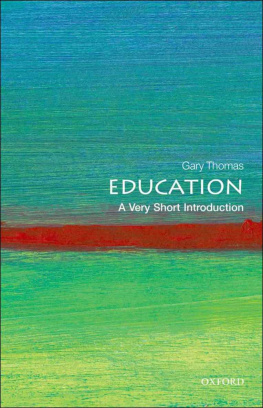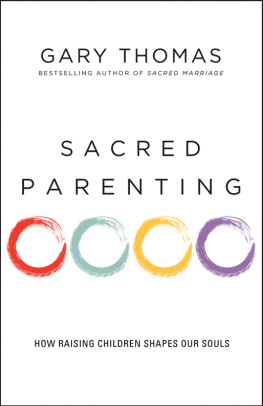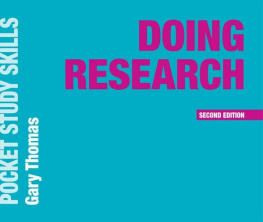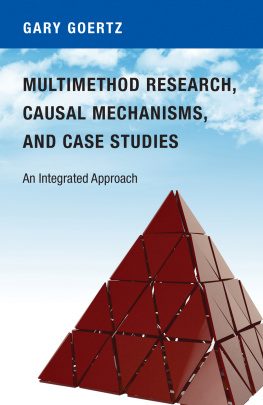The Anatomy of the Case Study
The Anatomy of the Case Study
SAGE Publications Ltd
1 Olivers Yard
55 City Road
London EC1Y 1SP
SAGE Publications Inc.
2455 Teller Road
Thousand Oaks, California 91320
SAGE Publications India Pvt Ltd
B 1/I 1 Mohan Cooperative Industrial Area
Mathura Road
New Delhi 110 044
SAGE Publications Asia-Pacific Pte Ltd
3 Church Street
#10-04 Samsung Hub
Singapore 049483
Gary Thomas and Kevin Myers 2015
First published 2015
Apart from any fair dealing for the purposes of research or private study, or criticism or review, as permitted under the Copyright, Designs and Patents Act, 1988, this publication may be reproduced, stored or transmitted in any form, or by any means, only with the prior permission in writing of the publishers, or in the case of reprographic reproduction, in accordance with the terms of licences issued by the Copyright Licensing Agency. Enquiries concerning reproduction outside those terms should be sent to the publishers.
Library of Congress Control Number: 2014950843
British Library Cataloguing in Publication data
A catalogue record for this book is available from the British Library
ISBN 978-1-4462-4863-8
ISBN 978-1-4462-4864-5 (pbk)
Editor: Jai Seaman
Production editor: Sushant Nailwal
Copyeditor: Kate Campbell
Proofreader: Jill Birch
Marketing manager: Sally Ransom
Cover design: Shaun Mercier
Typeset by: C&M Digitals (P) Ltd, Chennai, India
Printed in India at Replika Press Pvt Ltd
List of figures and tables
Figures
Tables
About the Authors
Gary Thomasis a professor of education at the University of Birmingham. His teaching and research have focused on inclusion, special education and research methodology in education, with a particular focus on case study. He has co-edited the
International Journal of Research and Method in Education and the
British Educational Research Journal and is currently executive editor of
Educational Review.
Kevin Myersis senior lecturer in Social History and Education at the University of Birmingham. He works on the history and sociology of education, and has specific interests in the application of psychological knowledge in school systems. He serves on editorial boards for the journals
History of Education,
History of Education Review and
Paedagogica Historica: International Journal for History of Education.
Preface
Gerring (2004: 341) recently suggested of case study that Practitioners continue to ply their trade but have difficulty articulating what it is that they are doing, methodologically speaking. The case study survives in a curious methodological limbo. This book grew out of a wish to help with the methodological limbo by seeking the anatomy of good case study discovering its vital organs and how they work together. Part of the problem seemed to be that case study takes such varied shapes and sizes; as such it is difficult to get any sense of identity about what is, despite its mutable nature, undeniably a coherent design framework. If we could gain some sense of the structure the essential ingredients of this protean form of inquiry we could then, we hoped, offer intending inquirers a Gestalt from which to consider ways of going about constructing and critiquing it.
With Gerrings assertion in mind, this book aims to:
- provide integrity and coherence for readers on recent ideas about case study; and
- offer to tutors and advanced students theoretical insights that have implications for the design and practice of case study.
Adapted versions of certain chapters published here have appeared previously in print. Part of the reason for their publication in a book is to offer an integration and synthesis of the ideas offered therein and to present them with new connective and illustrative material. In particular, parts of (Myers, 2011) was published first in Paedagogica Historica.
We are grateful to colleagues, friends and students at the University of Birmingham for their help, ideas and support, though any errors of fact or judgement are, of course, down to us.
Introduction
In writing a book about the anatomy of case study we intend to look at the way in which case study is constructed, at its necessary features and the way that these connect to make the case study succeed as a productive form of inquiry.
Our reason for thinking that such a project might be necessary came from the realization that what goes under the name case study can sometimes amount to not much more than a weakly differentiated collection of thoughts and quotations from interviews with very little in the way of analytical binding (see Luker, 2008, for a discussion). As the design of the case study is presented often as open-ended and untethered to any methodological frame, researchers particularly those researching their own practice may feel unguided about structure. The consequence is that the putative case study can therein lack purpose, integrity or analytical grip on any theme.
The problems of case study
There are two central problems that the case study as a form of social science inquiry has to face.
The first concerns its supposed deficiency in generalizing power. This problem can be addressed by looking at the notion of induction, and at what social science tries to do with this notion. It can be addressed also by questioning ideas about theory: as in most social science inquiry, case study is supposed to help develop theory, but little is said about the kind of theory that is supposedly developed. What exactly is it that we are developing?
The second is a more practical problem, and one that faces both novice and experienced researchers. It concerns the lack of structure surrounding this form of inquiry. What purposes can be served by the case study? Should case inquirers be seeking theory or trying to illustrate? Should they be looking retrospectively or at contemporary snapshots? Are multiple studies legitimate? And what is being sought when a case study is conducted? As Gerring (2004: 341) puts it: Practitioners continue to ply their trade but have difficulty articulating what it is that they are doing, methodologically speaking. The case study survives in a curious methodological limbo. De Vaus (2001: 219) agrees, in discussing the way that the case study is explained: Most research methods texts either ignore case studies or confuse them with other types of social research.






















